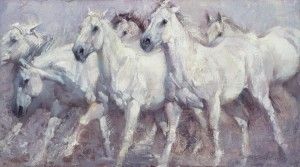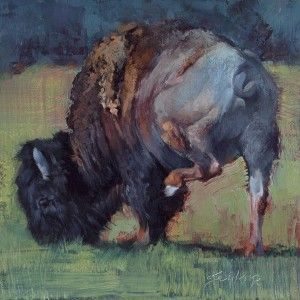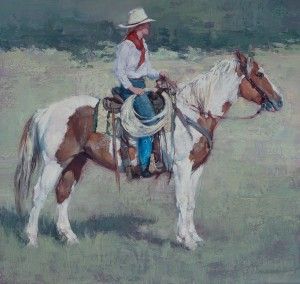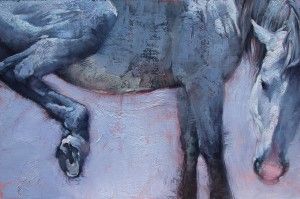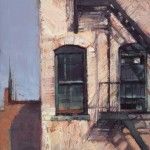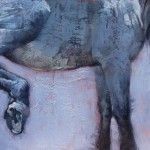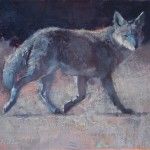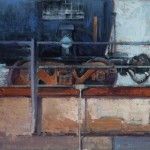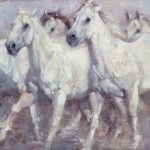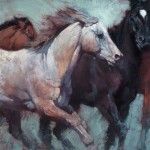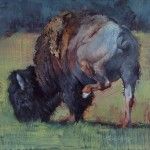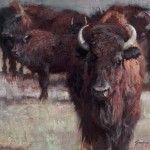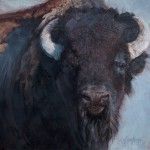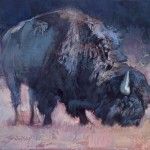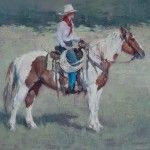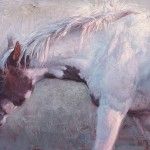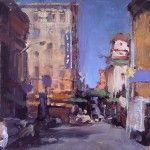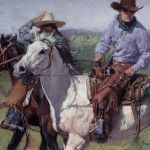Jill Soukup’s paintings benefit from a balance of analysis and intuition
By Gussie Fauntleroy
This story was featured in the September 2015 issue of Southwest Art magazine. Get the Southwest Art September 2015 print issue or digital download now–then subscribe to Southwest Art and never miss another story!
There’s something to be said for a thoughtful, systematic approach to painting, moving step by step through a process—from small black-and-white sketches to color studies and on to creating the full-size painting on canvas. It’s a process Jill Soukup has followed, with compelling results, for many years. It suits her sensibility, taps into the satisfaction she finds in getting things just so. But if you rotate that process 180 degrees and come to image-making from the opposite direction, interesting things can happen. That was the experience Soukup (pronounced SOAK-up) had when she attended a class at the Denver Art Students League recently. The instructor invited his students to pretend they were kids in a sandbox, allowing themselves to “goof off, play, just make marks,” Soukup says. “It was a good change, to loosen me up, to paint with boundless freedom.”
The first painting to emerge from this more spontaneous mindset was COYOTE TROT. Although it is connected in many ways to Soukup’s previous work, the image communicates a subtle feeling of quickness, wildness, and presence that adds to her already strong, evocative approach. It also clearly reflects elements of contemporary realism, which is how the artist describes her style. With its undefined background, where expressive colors and textures echo those of the coyote itself, the painting was a pivotal one for Soukup. “They were subtle changes, but there are qualities to the paint that were new to me,” she says. “Play was definitely a big part of it. There was a quality of being in the moment, almost as if I was not the one doing the painting. I place a lot of emphasis on the analytical part of painting. It’s good to be reminded of the critical component of intuition.”
Rather than rush head-on into a new way of painting, however, Soukup integrated the looser, unpremeditated approach into what she already does well. In doing so, she honors another deep-set value in her art and life: balance. It’s what prompted her decision to attend Colorado State University in Fort Collins—where she earned a bachelor’s degree in fine art with a concentration in graphic design while also indulging her interest in things like French and running track—rather than an art school. It’s also what underlies her inclination to juxtapose opposite elements in her work: structural and organic, angular and curved, man-made and intrinsic to the natural world.
The man-made and the natural were both important aspects of Soukup’s early life. Born in Buffalo, NY, she grew up in a suburb near Denver, the daughter of a veterinarian father and a mother with a soft heart for abandoned pets. Although her parents divorced when Jill was 8 years old, both continued to encourage and support her innate passion for drawing and other creative pursuits. Her father bought her art books—she clearly remembers the powerful impact of Drawing on the Right Side of the Brain—and invented imaginative forms of creative play for her and her brother. Horses, in particular, became objects of obsession for Soukup. Although there wasn’t money for a horse of her own, her mother made sure she had plenty of equine time. Just drawing a horse provided a sensation of touching the animal almost as visceral as caressing its flank, she recalls.
As a teen Soukup established a pet portraiture business, producing likenesses in chalk pastel. The money she earned financed a trip to Thailand with a friend when Jill was 18, another important, non-art-related element of balance in her developing years. At CSU she earned awards for illustration and design and served as an illustrator for the campus daily newspaper. Then followed 11 years in commercial graphic design after graduation, the majority of which she spent in the exhibits department at the Denver Museum of Nature and Science. There, Soukup interacted daily with an extremely creative team including diorama artists, photographers, and marketing experts. The experience reinforced such design fundamentals as color and composition; being part of the business end of commercial art served her well as she shifted into a fine-art career.
That shift went into gear when Soukup turned 30. “For some reason I realized how quickly a decade had gone by, and I knew it was now or never,” she says of full-time painting. “I wanted to start while I was still fairly young.” By then she had become engaged, relieving some of the pressure of single-income living. She was already taking classes with Quang Ho and other acclaimed painters at the Art Students League, where a fellow student lined up a show for Ho’s students at Denver’s Abend Gallery. It was Soukup’s first gallery show. She sold three of her four paintings and was invited to become a gallery artist at Abend.
So she cut back on work at the museum, arranging a flexible three-quarter-time schedule. But when she was offered representation at a second gallery not long afterward, she realized it was time to focus solely on fine art. She told her husband that if she couldn’t maintain an income equivalent to what she’d earned at the museum, she would seek a “regular” job again. “And I didn’t want to do that,” she says. She didn’t have to. In the years since then Soukup’s art has become part of a growing number of private, corporate, and public collections and earned multiple awards, including an Oil Painters of America Award of Excellence, the People’s Choice Award at the Coors Western Art Exhibit & Sale, and most recently, the Southwest Art Award of Excellence in the Quick Draw at Evergreen Fine Art’s Weekend in the West show.
These days, in the walk-out-basement studio at her home near the mountains outside Denver, the 46-year-old painter finds inspiration in her own collection of work by artists she admires, such as Kim English, Joseph Lorusso, T.D. Kelsey, Kevin Weckbach, and Robin Cole Smith. Lined up on shelves is Soukup’s large collection of Breyer model horses from her girlhood years. Nearby on a worktable, a recently purchased 1/5-size horse skeleton armature sits waiting for her hands to take up modeling clay to express her love of horses in another form. She tried sculpting a horse once before with less-than-stellar results, she says, smiling. “I’ll reuse that clay on a new one,” she adds. “Painting will always be my first love. But I think it makes you a better painter to have three-dimensional experience.”
A spirit of creative adventure has opened other doors in Soukup’s approach to painting as well. With BLUE ITCH, she took the risk of radically cropping the image of a horse with one back leg partly raised in mid-scratch. It’s a painting she’s had in the back of her mind for three or four years. “I was hesitant because it’s odd, but the idea kept coming back, and finally I gave myself permission to push myself,” she says. “Cropping isn’t anything new, but this felt edgier to me, to focus in on what’s important, that one leg. And with the colors, to use more subtle, duller blues.” In other recent color explorations she has taken hues used in painting one subject from life—a snowy landscape, for example—and applied the same colors to an entirely different subject, such as a building she photographed while on vacation in New York.
Soukup also cross-pollinates her own work by taking an element commonly associated with one type of subject and employing it in a subject from the opposite side of the organic/mechanical divide. It’s a way of playing with the tension between simplicity and complexity. “With an architectural image, I’ll find simplicity by zeroing in on smaller, finer portions of a building. Or I’ll take the complexity of architecture and apply it to a horse painting,” she explains. An example is her paintings featuring several horses running, their multiple moving legs creating negative and positive spaces that are as angular and intricate as the zigzagging staircase of a building’s fire escape.
Other strong images have emerged from Soukup’s visits to the famed Zapata buffalo ranch in southern Colorado and Zapata’s cattle ranch south of Colorado Springs. At the latter, she and other artists were invited to sketch and photograph a roping and branding operation involving thirty cowboys and cowgirls and a thousand cows and calves. It was a memorable, visually exciting experience that yielded engaging paintings with western themes.
This year, for the first time in several years, Soukup decided not to commit to a solo gallery show. Instead she is stepping back just a bit to discover what directions are calling her these days. She’s been reading art books, painting with other artists, taking classes— pulling deep from the waters of her personal creative well. “It’s such an important part of being an artist, constantly learning and going back to what really interests me,” she says. “I’m listening to what I get most excited about, and following where that leads.”
representation
Ann Korologos Gallery, Basalt, CO; Astoria Fine Art, Jackson, WY; Eisenhauer Gallery, Edgartown, MA; Saks Galleries, Denver, CO.
Featured in the September 2015 issue of Southwest Art magazine–click below to purchase:
Southwest Art September 2015 print issue or digital download Or subscribe to Southwest Art and never miss a story!
- Jill Soukup, Black Windows and Fire Escape, oil, 36 x 24.
- Jill Soukup, Blue Itch, oil, 20 x 30.
- Jill Soukup, Coyote Trot, oil, 12 x 14.
- Jill Soukup, Dark Freight, oil, 24 x 48.
- Jill Soukup, White Ramblings, oil, 8 x 14.
- Jill Soukup, Roan Rise, oil, 48 x 60.
- Jill Soukup, Bull Scratch, oil, 9 x 9.
- Jill Soukup, Cow Crossing, oil, 32 x 36.
- Jill Soukup, Bull Head, oil, 36 x 36.
- Jill Soukup, Blue Bull Grazing, oil, 12 x 13.
- Jill Soukup, Red Scarf and Paint, oil, 32 x 30.
- Jill Soukup, Pink Paint, oil, 30 x 40.
- Jill Soukup, China Town, oil, 6 x 6.
- Jill Soukup, Doubleback, oil, 24 x 30.
MORE RESOURCES FOR ART COLLECTORS & ENTHUSIASTS
• Subscribe to Southwest Art magazine
• Learn how to paint & how to draw with downloads, books, videos & more from North Light Shop
• Sign up for your Southwest Art email newsletter & download a FREE ebook






